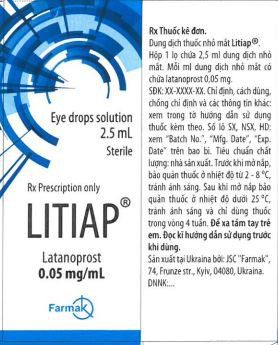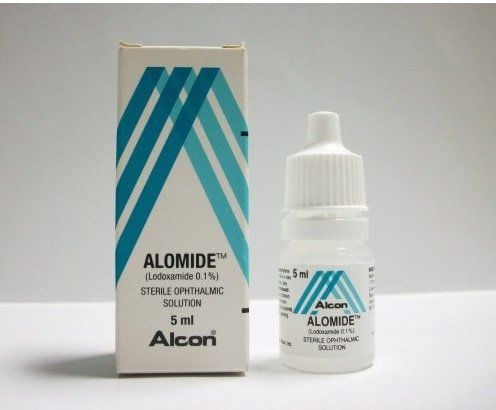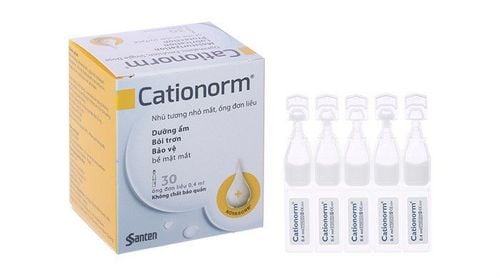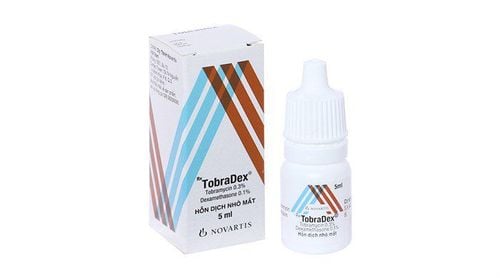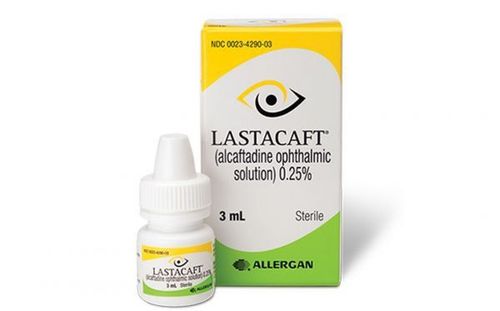This is an automatically translated article.
Spring eye conjunctivitis is a common eye allergy. Besides common oral medications, patients can use Lodoxamide Tromethamine eye drops. So what is Lodoxamide?1. What is Lodoxamide Tromethamine?
Lodoxamide Tromethamine is used to treat certain allergic eye conditions such as vernal keratitis, conjunctivitis, or spring keratitis.The effect of the drug is to prevent itchy eyes that occur in the above-mentioned allergic eye conditions. Lodoxamide Tromethamine is a mast cell stabilizer and blocks certain natural substances (such as histamine, leukotriene) that cause eye allergy symptoms.
2. How to use Lodoxamide Tromethamine Drops
To use eye drops like Lodoxamide Tromethamine Drops, the user needs to wash their hands first. To limit contamination, the user must not touch the tip of the dropper or let it touch the eye or any other surface directly.At best, the user should not wear contact lenses during the use of Lodoxamide Tromethamine.
Lodoxamide Tromethamine Drops directly onto the affected eye, usually 4 times daily or as directed by a physician. Treatment can last for 3 consecutive months.
Steps to use Lodoxamide Tromethamine:
The patient tilts his head back, looks up and pulls the lower eyelid down to form a drug compartment; Hold the dropper directly over the eye and place 1 drop of Lodoxamide Tromethamine into the cavity; Look down and gently close your eyes for 1-2 minutes; Place a finger in the corner of the eye near the nose and press gently, this will prevent Lodoxamide Tromethamine from draining out of the eye; Try not to blink and rub your eyes after instillation; Repeat the above steps if the patient's dose of Lodoxamide Tromethamine is more than 1 drop/time; Apply the same drops to the other eye if prescribed by the doctor; After using Lodoxamide Tromethamine eye drops, the patient does not need to wash the dropper, but keep the cap tightly closed. If you are using another eye medication (eg, drops or ointment), wait at least 5 minutes after instilling Lodoxamide Tromethamine Drops before using those medications. Note that eye drops should be used before applying the ointment.
Use Lodoxamide Tromethamine exactly as directed for best results. Choose evenly spaced Lodoxamide Tromethamine instillation times and apply the same every day. Patients should continue to use Lodoxamide Tromethamine for the full prescribed time.
It may take several days of continuous use of Lodoxamide Tromethamine Drops for symptoms to begin to improve. If you want immediate relief of symptoms (especially itchy eyes), use another fast-acting medication (such as antihistamine eye drops, decongestants, or non-steroidal anti-inflammatory drugs-NSAIDs) along with other fast-acting medications. Lodoxamide Tromethamine as directed by your doctor. Inform your doctor if eye irritation persists or worsens.

Hãy rửa tay sạch sẽ trước khi dùng thuốc Lodoxamide
3. Lodoxamide Tromethamine side effects
Common side effects when using Lodoxamide:Burning, pain or discomfort in the eyes; Feeling like something is in the eye; Dry nose, sneezing; Headache, dizziness; Sleepy; Blurred vision; Watery or dry eyes; A sticky feeling in the eyes, scabs at the corners of the eyes or on the eyelids. If any of these unusual symptoms while taking Lodoxamide Tromethamine persist or worsen, tell your doctor or pharmacist immediately for instructions.
Tell your doctor right away if you have any of these uncommon but serious side effects of Lodoxamide Tromethamine:
Eye pain; Swelling of the eye or surrounding area; Burning sensation in the eyes; Vision change. A serious drug allergy to Lodoxamide Tromethamine is very rare with signs of an allergic reaction such as: rash, itching/swelling of the face/tongue/throat, dizziness, trouble breathing.
4. Some notes when using Lodoxamide Tromethamine Drops
Before using Lodoxamide Tromethamine eye drops, tell your doctor or pharmacist if you are allergic to this or other allergies. Lodoxamide Tromethamine medicinal products may contain inactive ingredients (preservatives such as benzalkonium chloride), which can cause allergic reactions or other problems.Inform your doctor of all previous medical history when using Lodoxamide Tromethamine Drops. Following instillation of Lodoxamide Tromethamine, a patient's vision may be temporarily reduced. Lodoxamide Tromethamine may also make patients dizzy or drowsy. Therefore, limit the use of substances that can cause dizziness or additional drowsiness such as alcohol or marijuana. Also, do not drive, use machinery, or perform tasks requiring alertness or clear vision until it is safe to do so.
During pregnancy, Lodoxamide Tromethamine Drops should be used only if clearly needed and the risks and benefits need to be discussed with the treating physician. Lodoxamide Tromethamine is not known to pass into breast milk, so to be on the safe side consult your doctor before breast-feeding.

Hạn chế dùng rượu, đồ uống có cồn sau khi nhỏ thuốc Lodoxamide
5. Lodoxamide Tromethamine Drops . Drug Interactions
The doctor or pharmacist may have detected and taken measures to manage possible drug interactions in the patient. Patients need to adhere to the treatment, do not arbitrarily start, stop or change the dose of any medicine without the permission of the doctor.Before using Lodoxamide Tromethamine, talk to your doctor or pharmacist about all prescription and nonprescription herbal products you are using. Lodoxamide Tromethamine can be harmful if swallowed. Symptoms after swallowing Lodoxamide Tromethamine may include: flushing, feeling hot in the body, unusual tiredness, sweating, diarrhea. Avoid exposure to common eye allergens such as pollen, weeds, dust mites, and pet dander.
Lodoxamide Tromethamine Drops is only prescribed for the current allergic eye condition, the patient should not arbitrarily use it for another medical condition unless directed by a doctor. Store Lodoxamide Tromethamine eye drops bottles upright at room temperature between 15-27 degrees Celsius, away from direct sunlight and high humidity.
Please dial HOTLINE for more information or register for an appointment HERE. Download MyVinmec app to make appointments faster and to manage your bookings easily.
Reference source: webmd.com



